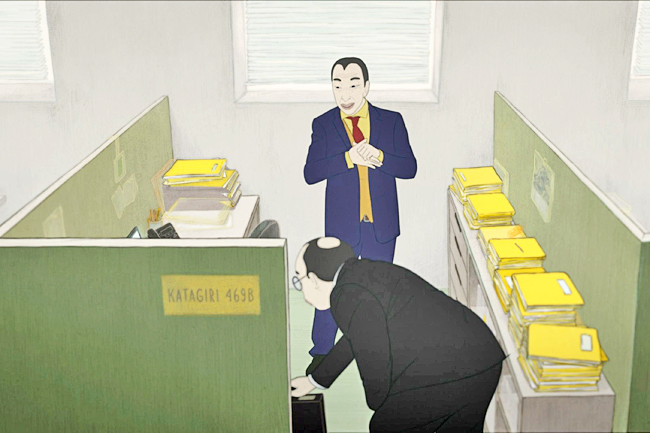THE WASHINGTON POST – The best part about Blind Willow, Sleeping Woman, an animated feature adapted from a handful of short stories by Haruki Murakami, is the cats.
Rendered using a motion-capture process, the felines are realistically playful – or menacing, when called for. Unfortunately, the strange world of this film by writer-director Pierre Földes (which includes an anthropomorphic talking frog) is also populated by people. And these people are unappealing grotesques who don’t particularly suit the Japanese author’s deadpan tone.
The episodic film’s intertwining and only loosely related narratives are, for the most part, mundane, taking place shortly after a 2011 earthquake that has rocked Tokyo.
Two characters appear throughout, both unsatisfied employees of the same bank: Komura (voice of Ryan Bommarito in this English-language dub of the French film) is distracted at the office after his wife, obsessed with TV coverage of the devastation, abruptly leaves him and her pet cat that has gone missing.
Meanwhile, the debt collector Katagiri (Marcelo Arroyo) is caught up in something more fantastic: He’s visited by the aforementioned frog, a mysterious creature that is convinced the middle-aged office worker is the only person who can save Tokyo from a tsunami.
It’s an intriguing concept, familiar to anyone who knows Murakami’s work. But the character design devised by Földes (who also composed the film’s self-consciously quirky score and even voiced the frog) is too often distracting, with oddly shaped heads, as if in a painting by German artist Otto Dix.


The look suits Katagiri – you wouldn’t expect someone who talks to frogs to look ordinary – but when it comes to the domestic crises that dominate the film, the distorted features get in the way of quiet drama.
What’s more, Földes overloads the narrative by shoehorning half a dozen or so short stories into the plot. The most successful adaptations of Murak mi – Lee Chang-dong’s Burning and Ryusuke Hamaguchi’s Oscar-winning Drive My Car – take a single story and expand its world.
Yet the six sprawling chapters of Blind Willow don’t linger long enough in the mind to establish that elusive Murakami touch for more than a few minutes at a time.
Nevertheless, the film manages to work, if only in fits and starts, when the setting is intimate enough that the aesthetics don’t get in the way. There are brief moments when Földes and his voice cast capture Murakami’s essence, conveying a deceptively calm exterior that hides startling and sometimes absurd forces beneath.
Most curiously, Földes initially intended Blind Willow, Sleeping Woman to be a hybrid of live action and animation. Somehow, for all the work that went into the film, it comes across as something that may have worked better as an audiobook.
There are sequences of efficient dialogue that – if you close your eyes – unspool the kind of low-key, elliptical tension that Murakami seems to be able to pull off in his sleep. But as soon as you open them again, the aggressively odd visuals ruin the illusion.
Except for the cats. – Pat Padua






